
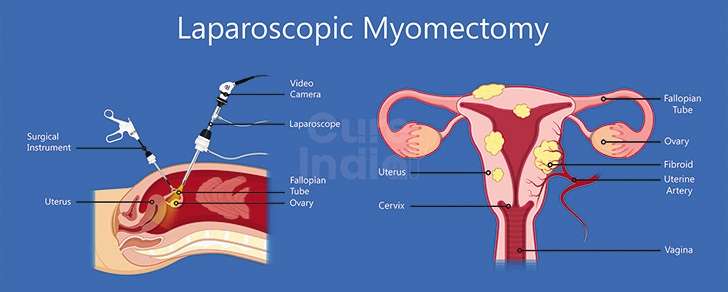
In non-medical parlance, Laparoscopic Myomectomy is a medical procedure involving the removal of fibroids from the uterus. Also known as the fibroid surgery in the layman’s language, the key purpose of such a surgical procedure is to remove fibroids from the uterus lining instead of removing the uterus itself (called Hysterectomy). Your doctor may choose Myomectomyover Hysterectomy for the following reasons: Patient has the ability to bear children during her productive life; Removal of infertility conditions and a probable hindrance to fertility; and the Patient is interested in keeping her uterus intact.
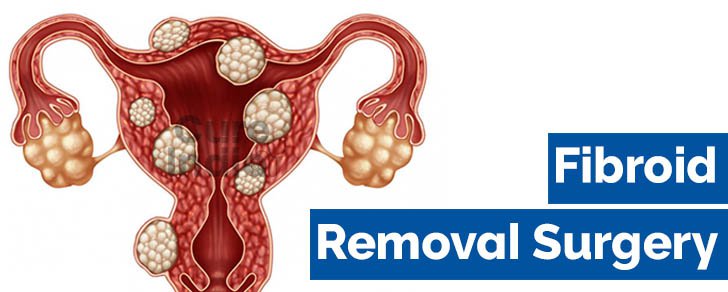
Though myomectomy surgery is termed as the safest known procedure, it does have a certain level of risks associated. A few of these risks involve:
Excessive blood loss: As patients of uterine myomectomy are already suffering from heavy blood loss during the menstrual cycle, it is quite evident she is anaemic in nature and prone to complications related to blood loss during the surgery. To avoid extra blood loss during the fibroids laparoscopic surgery, doctors could be using several medical procedures. The surgeon uses tourniquets and clamps around the fibroids to stop excessive bleeding. Alternatively, evaluating the condition of the patient, the doctor could inject medications around fibroids with an aim to clamp down blood vessels around the fibroids. This would thus check excessive bleeding in the patient during surgery.
Hysterectomy: In rarest cases, if the patient is suffering from uncontrollable bleeding, the doctor could advise hysterectomy as a final outcome to contain excessive blood loss. The doctor conducting open myomectomy could also recommend complete removal of the uterus if he finds other complications caused by fibroids.
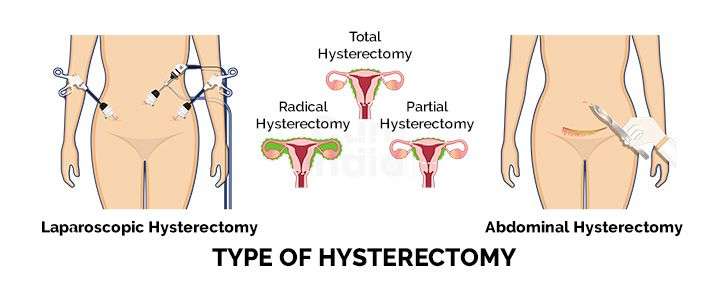
Cancerous Tumor: In certain cases, it has been observed that cancerous tumors inside uterus have been mistaken for fibroids. In most of such cases, the surgeon would advise for removal of the uterus, especially when a tumor grows in the uterus, and the doctor cannot advise morcellation as a process of tumor removal.
Complications in Childbirth: After fibroid surgery to get pregnant yet another thought that becomes a serious concern for the patient. Post fibroid removal surgery, a patient can face difficulty during pregnancy. As the patient has already gone through a myomectomy procedure, it increases the chances of rupture of the uterine wall if the doctor performing caesarian makes a deep incision. To avoid such a situation, the doctor may recommend a caesarian delivery. Fibroid removal surgery may reduce complications.
There are different procedures for fibroid removal which your surgeon can resort to. Depending upon the fibroid growth, size and position, the surgeon can choose from any of the following available myomectomy procedure:
Hysteroscopic myomectomy: If the surgeon finds that the fibroids that have developed in the uterus wall are small and that which bulge into your uterus (a condition called submucosal fibroids), the surgeon would suggest hysteroscopic myomectomy. Myomectomy procedure involves the surgeon, who would insert instruments through the vagina and cervix into your uterus and remove the bulging fibroids. The surgeon would insert a sterile solution for the purpose of expanding the uterine cavity for him to examine the uterine walls. Finally, the surgeon (with the help of hysteroscopic morcellator or resectoscope) would remove the fibroids from the uterus by taking out pieces of fibroids accumulated on uterus walls. This procedure would be repeated again if the surgeon is not sure that the fibroids have been completely removed.
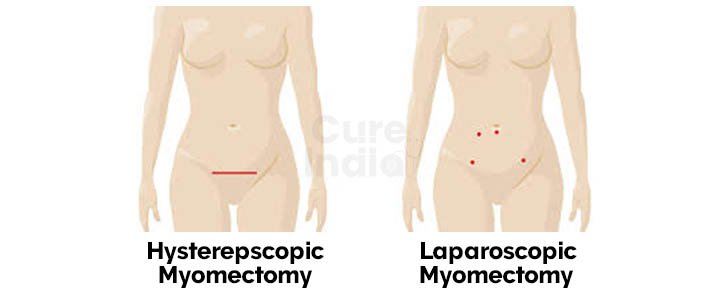
Laparoscopic myomectomy: Unlike hysteroscopic myomectomy, this procedure is a little complex. The surgeon makes a small incising near the stomach – bellybutton and after making the incision inserts a laparoscope into the abdomen, the laparoscope is fitted with the camera through which the surgeon sees the exact location and formation of fibroids. Lastly, the surgeon would remove the fibroids via the instruments inserted through a small incision in the abdominal wall. Uterus healing after myomectomy has a fair chance. Although other critical things have also to be considered and reconsidered alongside.
CureIndia helps you choose the right doctor for your medical treatment. Most of the doctors in our associated hospitals have been internationally trained and are active members of many international medical councils and associations. Let's hear from some of the most reputed doctor's for laparoscopic myomectomy in India.
Patients who have successfully undergone myomectomy lead to normal menstrual bleeding. They also report less pelvic pressure and an overall improvement in the fibroid symptoms. Fibroid removal surgery is a simple and safe procedure adopted by most of the doctors in order to remove fibroids from the uterus. After fibroid removal surgery, a patient can heal up quickly in one-two weeks’ timeframe and thus can lead a normal living thereafter. Myomectomy procedure is hassle-free, considering the fact that it is carried out by experts. Fibroids uterine myomectomy can only be performed, once the things are pretty clear patient has fibroids.

In general, many of the women who are having fibroids don’t have any apparent symptoms. There are those who complain of various symptoms which may vary from patient to patient. Also, the symptoms can be attributed to growth, location and number of fibroids in the uterus.
Women who have uterine fibroids complain of the following symptoms:
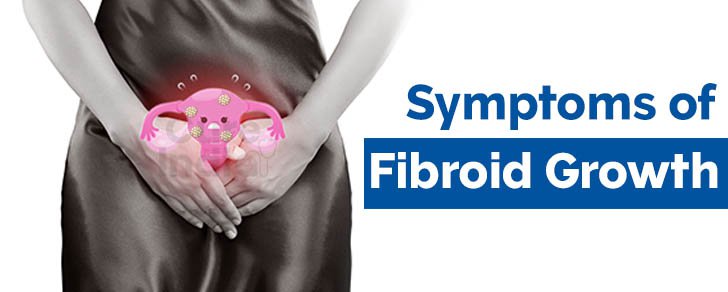
There could be innumerable reasons for fibroids to get developed in the uterus. Some of the reasons can be attributed to the following:
Hormonal changes: After attaining a certain age, there are changes that happen in the women body. As according to one study about 30 per cent of women who have attained the age of 35 project symptoms of fibroids and about 60 to 80 per cent of women above the age of 50 have one or another problem pertaining to fibroids. The two hormones estrogen and progesterone which are responsible for the development of the uterine can be termed as fibroid growth simulators. With ageing, the secretion of both of these hormones vary, this also may correlate to the formation of fibroids.
Genetic mutations: Another possible reason for the creation of fibroids in the uterine wall can be attributed to a mutation in single gene Med12. It has been researched that about 70% of uterine fibroids are due to mutation in Med12.
Extracellular matrix (ECM): Excessive production of extracellular matrix (ECM) is another reason for the formation of fibroids in the uterus wall. The main purpose of ECM is to bind cells together and if there is a high level of production of ECM, it causes fibroid formation and growth.
While fibroid removal is the key concern among women patients, procedures like hysteroscopic myomectomy are undertaken appropriately. If seen from an overall perspective, uterus healing after myomectomy may take a few days. And from the overall scenario, the surgery is indeed a reliable medical solution to go with.
